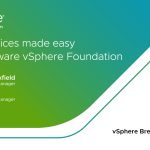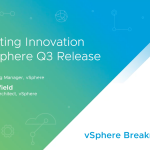By William Lam, Sr. Technical Marketing Engineer
From time to time I get questions on how to access the advanced settings for a virtual machine and how to go about searching for the settings using the VM’s .vmx configuration file. Though the advanced settings are stored in the .vmx configuration file, they can also be accessed and viewed using the vSphere Client.
These advanced settings are stored as a key/value pair and is primarily used by VMware to add additional information or configurations to a specific VM. These settings are persistent throughout the life of the VM, even when you clone the VM, the settings are also copied. One example of where this is used, is with VMware’s vShield product. Advanced settings are used in vShield Manager and vShield App VM to help identify their role and actions within the vShield solution.
If you wish to list all the advanced settings for a VM, you can easily automate this with the help of the vSphere API. As part of the VM’s configuration, there is a property in the vSphere API called extraConfig, which is an array that contains the key/value pair settings.
Here is an example of listing the advanced settings for a VM using the vSphere SDK for Perl script called vmAdvSettings.pl:
$ ./vmAdvSettings.pl –server vcenter50-3 –username root –vmname MyVM –operation list
Key: ethernet0.filter0.param0 Value: vshield-dvfilter-module
Key: ethernet0.filter0.param1 Value: uuid=5019b662-a14c-8166-9ce3-61f362de05a3.000
Key: evcCompatibilityMode Value: FALSE
Key: guestCPUID.0 Value: 0000000b756e65476c65746e49656e69
Key: guestCPUID.1 Value: 000106a400010800809822010febfbff
Key: guestCPUID.80000001 Value: 00000000000000000000000128100800
Key: hostCPUID.0 Value: 0000000b756e65476c65746e49656e69
Key: hostCPUID.1 Value: 000106a400010800809822210febfbff
Key: hostCPUID.80000001 Value: 00000000000000000000000128100800
Key: hpet0.present Value: true
Key: migrate.hostLogState Value: none
Key: migrate.migrationId Value: 0
Key: nvram Value: MyVM.nvram
Key: replay.supported Value: false
Key: scsi0.pciSlotNumber Value: 16
Key: snapshot.action Value: keep
Key: uuid.action Value: create
Key: virtualHW.productCompatibility Value: hosted
Key: vmci0.pciSlotNumber Value: 32
Key: vmotion.checkpointFBSize Value: 4194304
Key: vmware.tools.installstate Value: none
Key: vmware.tools.internalversion Value: 2147483647
Key: vmware.tools.lastInstallStatus Value: unknown
Key: vmware.tools.requiredversion Value: 8384
You can also query a specific advanced setting if you already know the key. Here is an example by specifying –key parameter:
$ ./vmAdvSettings.pl –server vcenter50-3 –username root –vmname MyVM –operation list –key ethernet0.filter0.param1
Key: ethernet0.filter0.param1 Value: uuid=5019b662-a14c-8166-9ce3-61f362de05a3.000
Here is an example of listing the advanced settings for a VM using PowerCLI:
Note: The functions used in this PowerCLI example can be found here and should be added to your session first.
Get-VM MyVM | Get-VMAdvancedConfiguration
Key Value
— —–
ethernet0.filter0.param0 vshield-dvfilter-module
ethernet0.filter0.param1 uuid=5019b662-a14c-8166-9ce3-61f362de05a3.000
guestCPUID.0 0000000568747541444d416369746e65
guestCPUID.1 00100f230000080080802001078bfbff
guestCPUID.80000001 00100f231000036f000001e9ebd3fbff
userCPUID.0 0000000568747541444d416369746e65
userCPUID.1 00100f230004080080802001078bfbff
userCPUID.80000001 00100f231000036f000001e9ebd3fbff
evcCompatibilityMode false
config.readOnly false
replay.filename
unity.wasCapable false
checkpoint.vmState
replay.allowFT false �
160;
vshield.vmtype Manager
vshield.vmversion 5.0
pciBridge5.present true
vshield.vmbuild 473791
a57d4b11.vswp
scsi0:1.ctkEnabled true
vmware.tools.internalversion 8384
vmware.tools.requiredversion 8384
vmware.tools.installstate none
vmware.tools.lastInstallStatus unknown
migrate.hostLogState none
migrate.migrationId 0
You can also query a specific advanced setting using the PowerCLI functions if you already know the key. Here is an example by specifying -key parameter:
Get-VM MyVM | Get-VMAdvancedConfiguration -Key “ethernet0.filter0.param1”
Key Value
— —–
ethernet0.filter0.param1 uuid=5019b662-a14c-8166-9ce3-61f362de05a3.000
As I mentioned earlier, VMware is the primary consumer of the advanced settings, but did you know, it is also available for everyone to use? It is just as easy to query for the settings as it is to add your own custom key/value pair by using the vSphere API UpdateOptions method.
Here is an example of using the vSphere SDK for Perl script:
./vmAdvSettings.pl –server vcenter50-3 –username root –vmname MyVM –operation update –key asset.tag –value ABC123
Reconfiguring “MyVM” with advanced setting: “asset.tag = ABC123” …
Successfully updated advanced setting for “MyVM”!
Here is an example of using PowerCLI:
Get-VM MyVM | Set-VMAdvancedConfiguration -Key “asset.tag” -value ABC123
Set Advanced configuration for MyVM: asset.tag = ABC123
If you are using vCenter Server, there is also a feature called Custom Attributes which provides a similar mechanism to add custom fields but is applicable to both a VM and/or ESX(i) host. These custom fields also persist throughout the life of a VM and ESX(i) host, but the only difference is these settings are stored in the vCenter database and not with the actual VM or ESX(i) objects. You can view these custom fields in the VM and ESX(i) column tabs in your vCenter Server.
It is recommended that you use the custom attributes as a way to centrally manage and create custom fields for your VM and ESX(i) hosts. This allows for the data to be centralized in your vCenter Server and you do not need to worry about individual VM configurations.
Additional Resources:
- vSphere SDK for Perl script to help create/automate VM custom attributes.
- PowerCLI can be used to automate custom attributes as seen here.
Get notification of new blog postings and more by following lamw on Twitter: @lamw

















